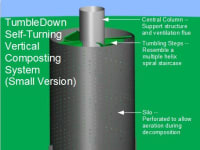The TumbleDown Self-Turning Vertical Composting System repeatedly and thoroughly mixes ("turns") compost without machinery or labor. The design resembles a multiple helix spiral staircase within a silo. The mixture of organic materials tumbles down from one stairstep to the next. “Self-Turning” refers only to the spontaneous tumbling of the compost. The structure itself does not move and has no moving parts.
The process is driven by two of nature's most powerful forces, gravity and decomposition.
Compostable waste is loaded at the top of the silo. Each stairstepful of organic matter is propped up by the compost on the stairstep just below and in turn props up the mass of compost on the stairstep just above. As decomposition progresses, the tangle of plant matter loses volume and structural integrity. As a mass near the bottom of the silo weakens and crumbles (or finished compost is withdrawn for use) the mass immediately above loses support. The unsupported mass crumbles and tumbles down onto the next lower step. This in turn causes the mass just above to crumble and tumble also, starting a chain reaction of crumbling tumbling subsidence which propagates all the way up the “staircase” to the top of the silo.
Composting is a quintessentially green technology, but keeping large-scale composting "green" can be as challenging as any other industry.
• Mechanized composting on a commercial scale is expensive and energy intensive, requiring many workers and heavy earth-moving equipment or costly specialized machinery
• Commercial composting occupies expansive paved lots with long compost piles called windrows
• Uneven drying in windrows often leads to smoky long-smoldering fires from spontaneous combustion
• Mechanized composting also generates noise and windblown dust and debris unwelcome in urban and suburban neighborhoods
• The high temperatures and harsh mechanical turning of windrows on hard paved surfaces are incompatible with vermiculture, the use of earthworms to enhance and accelerate composting
The TumbleDown system rises to these challenges.
• Compost gently turns itself without machinery or labor or fuel consumption
• Scalable -- from small residential kits to enormous industrial installations
• Highest-volume output on the smallest possible footprint
• Naturally regulates temperature and moisture content, effectively suppressing spontaneous combustion
• No unwelcome mechanical noise, windblown dust or debris
• Ideal for nurseries, landscaping companies, big box home and garden stores and even municipal operations in urban and suburban parks
• Institutional sources of organic waste can reduce waste management costs or achieve compliance with environmental regulations
• Exceptional compatibility with sustainable vermiculture
Small kit-built plastic silos holding a few hundred pounds of compost would be suitable for residential gardens. One or two galvanized sheet steel silos holding several tons of composting material could serve a commercial nursery or university campus. Massive reinforced concrete silos holding thousands of tons of organic material would allow the most efficient production of compost on an industrial scale.
The TumbleDown Self-Turning Vertical Composting System minimizes the cost and complications of compost, making this "green gold" available in more places for more people.
Like this entry?
-
About the Entrant
- Name:J Swift
- Type of entry:individual
- Patent status:none





